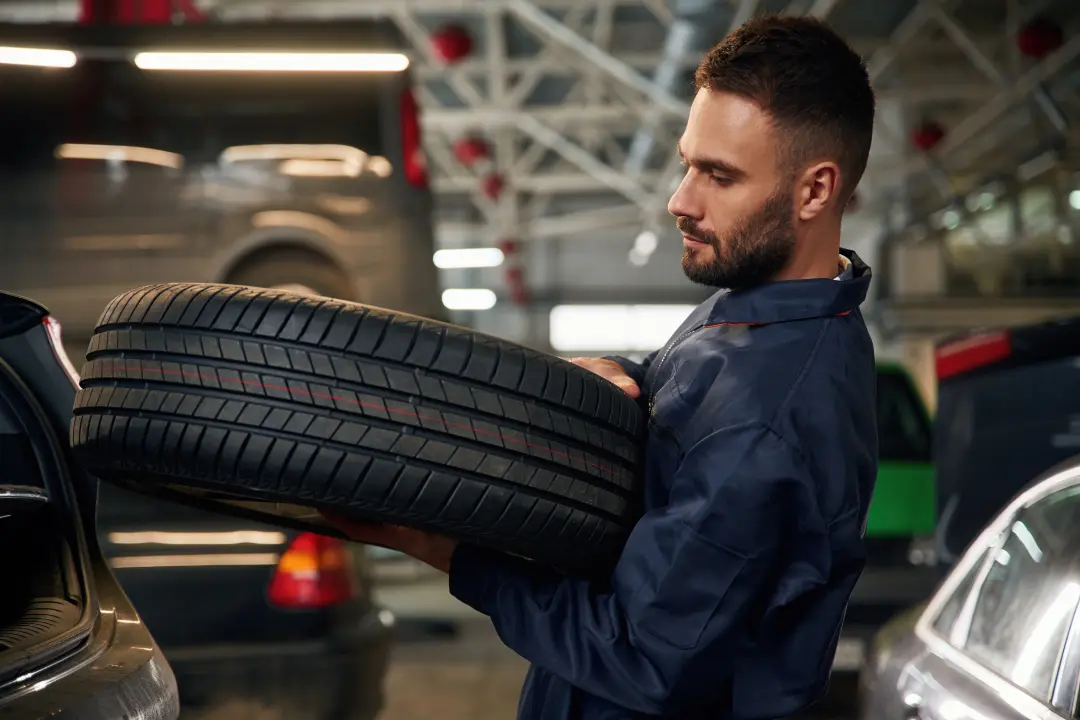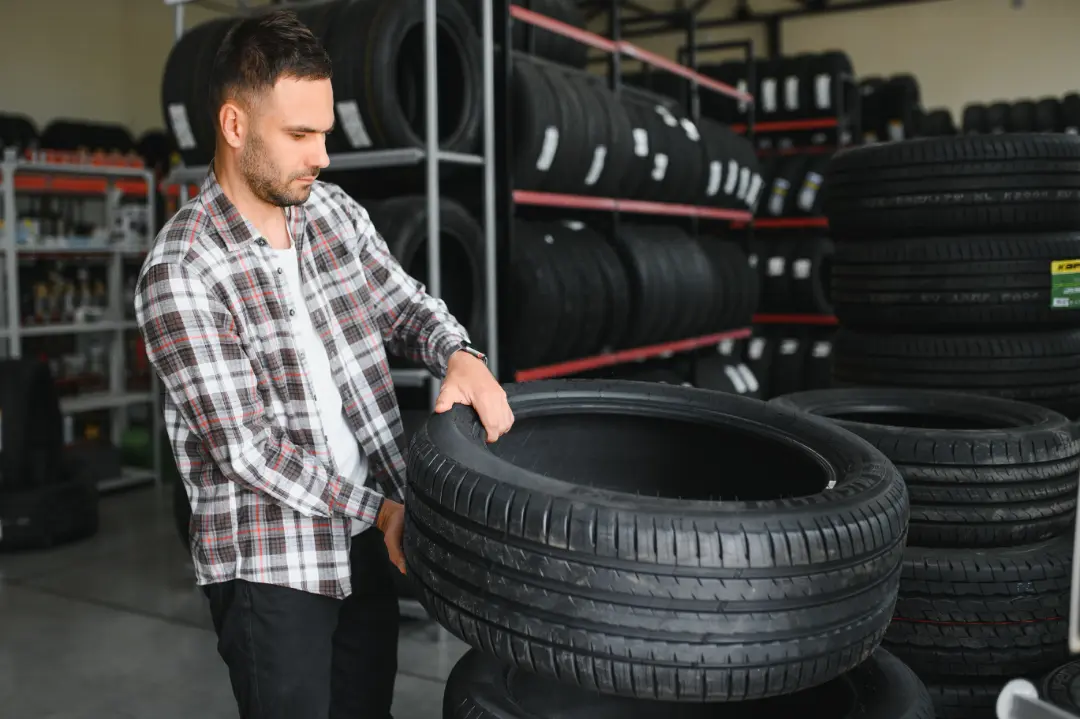What are run-flat tyres? With run-flat tyres, you can avoid the dangerous and inconvenient task of changing a flat tyre on the side of the road. These tyres are designed to allow drivers to continue driving for a limited distance after a puncture, providing a safer alternative to conventional tyres that can deflate rapidly.
Key Takeaways
- Run flat tyres provide increased safety and convenience, with improved handling and stability.
- They have a higher cost than conventional tyres, as well as potential drawbacks such as shorter lifespan and harsher ride quality.
- All Vehicle Services offers expert advice on running flat tyre selection from major manufacturers.
Understanding Run Flat Tyres: The Basics
Run flat tyres are specially designed to allow you to keep driving even when they experience a puncture or a significant loss of tyre pressure. Their unique construction provides extended mobility, enabling you to reach a safe location without immediately changing the tyre or installing a spare. Keep in mind that run flat tyres aren’t designed for extended use when they are flat. Also, avoid driving at high speeds with these tyres. The recommended driving distance after a puncture is 50 miles at a maximum speed of 50 mph.
Run flat technology is becoming increasingly popular among vehicle manufacturers, particularly for newer cars that require a tyre pressure monitoring system (TPMS). The TPMS plays a significant role when using run flat tyres, as it sends an automatic alert in case of a puncture, helping you stay informed and take necessary precautions.
The Mechanics Behind Run Flat Tyres
The secret behind the puncture-resistant capabilities of run flat tyres lies in their reinforced sidewalls and tough rubber inserts. These features allow run flat tyres to temporarily support the weight of a vehicle even after a puncture, reducing the risk of a dangerous blowout.
Run flat tyres are different from conventional tyres in that they can support the weight of the vehicle even when flat or significantly underinflated. This is due to their reinforced sidewalls and unique run flat system component that enables the tyre to maintain its shape even when deflated.
There are various types of run flat tyres available in the market, each with its unique set of features and benefits. Some examples include:
- Dunlop’s special compound for a more comfortable drive
- Pirelli’s RSC technology for extra stability
- Continental’s self-supporting run flat technology for low section tyres
Consult with a tyre specialist to find the best run flat tyre option that suits your vehicle and driving needs.
Run Flat Tyres vs Conventional Tyres: A Comparison
The main distinction between run flat and conventional tyres is in their response to punctures. Run flat tyres enable drivers to continue driving for a limited distance following a puncture, whereas conventional tyres can deflate quickly under similar circumstances.
It is possible to fit conventional tyres on a BMW vehicle that was originally equipped with run flat tyres. However, TyreSafe recommends maintaining the current vehicle setup of run flat tyres rather than switching to conventional tyres. Mixing run flat and conventional tyres on a vehicle is not recommended, as their handling characteristics may vary.
When considering run flat tyres, it’s important to balance their advantages like increased safety and convenience, against potential drawbacks like higher cost and a different ride quality. Consult a tyre specialist or your vehicle manufacturer for personalized advice.
The Lifespan of Run Flat Tyres
The lifespan of run flat tyres hinges on factors like frequency of use, road conditions, and regular maintenance. Typically, under normal conditions, run flat tyres are estimated to last between 30,000 and 40,000 miles. Yet, be mindful that run flat tyres might wear out faster than conventional tyres owing to their rigid construction.
In the event of a puncture, the recommended driving distance on run flat tyres is no more than 50 miles at a speed of approximately 30 mph. Exceeding this limit may cause further damage to the tyre, reducing its lifespan and compromising its structural integrity.
To prolong the lifespan of your run flat tyres, follow these tips:
- Maintain regular air pressure checks
- Practice responsible driving habits
- Avoid aggressive driving
- Avoid excess weight in the vehicle
These factors can negatively impact the longevity of run flat tyres.
Recognizing Run Flat Tyres on Your Vehicle
To identify run flat tyres on your vehicle, you can check the manufacturer’s information or inspect the tyre sidewall for specific symbols or markings that indicate a run flat design. Different tyre manufacturers utilize various markings, but any tyre marked with the symbol ‘RF’ is a run flat tyre.
Another indication that your car has run flat tyres is the absence of a spare tyre or foam filler tyre repair kit in the boot of the car. If you are still uncertain about the type of tyres on your vehicle, consult your trusted local garage or contact the vehicle manufacturer for precise information.
Being aware of the run flat tyres on your vehicle is crucial, as they bring unique benefits and need specialized maintenance. Recognizing and understanding the features of run flat tyres can help maintain your vehicle’s safety and performance.
Advantages of Choosing Run Flat Tyres for Your Car
One of the main advantages of run flat tyres is their increased safety and convenience. When a puncture occurs, run flat tyres enable drivers to keep driving and reach a safe location without having to change the tyre or install a spare immediately. This is especially beneficial in hazardous conditions or when roadside assistance is unavailable.
Run flat tyres offer several advantages:
- They eliminate the need for a spare tyre, which can be cumbersome to store and maintain.
- They provide improved handling and stability due to their reinforced sidewalls, which offer support even when the tyre is deflated.
- This ensures the tyre maintains its shape, improving vehicle stability and control.
By choosing run flat tyres, you can enjoy the peace of mind that comes with knowing your vehicle is equipped to handle unexpected punctures, providing a safer and more convenient driving experience.
Potential Drawbacks of Run Flat Tyres
While run flat tyres offer numerous advantages, there are some potential drawbacks to consider. One such drawback is the higher cost of run flat tyres compared to conventional tyres. This increased cost can be attributed to their unique construction and performance capabilities.
Another potential drawback is the shorter lifespan of run flat tyres, which may wear out more quickly than conventional tyres due to their stiffer construction. As mentioned earlier, factors such as driving habits and vehicle weight can significantly impact the longevity of run flat tyres.
Finally, the rigid construction of run flat tyres might lead to a harsher ride quality compared to conventional tyres. The reinforced sidewalls and less flexible design limit the tyre’s capacity to absorb bumps and vibrations, possibly resulting in a less comfortable ride. It’s necessary to balance the pros and cons of run flat tyres when deciding if they are the suitable choice for your vehicle.
Repairing Run Flat Tyres: Is It Possible?
Repairing run flat tyres is generally discouraged by manufacturers and retailers, as their strength and integrity may be compromised after a puncture. The reinforced sidewalls and internal structure of run flat tyres make them more difficult to patch or plug compared to regular tyres.
There are exceptions to the rule of not repairing run flat tyres, and the decision ultimately depends on the opinion of the tyre manufacturer. Some manufacturers permit repairs as long as the sidewall is not cut or gouged, while others stipulate that their run flat tyres repairable cannot be repaired.
In light of the potential risks and uncertainties associated with repairing run flat tyres, it is generally recommended to replace rather than repair a damaged run flat tyre. Consult with your tyre manufacturer or a trusted tyre specialist for guidance on the best course of action for your specific situation.
Upgrading to Run Flat Tyres: What You Need to Know
Switching to run flat tyres requires meticulous consideration of aspects like vehicle compatibility, handling characteristics, and possible benefits and drawbacks. Make sure the run flat tyres you select align with your vehicle’s manufacturer recommendations.
Be aware that run flat tyres, unlike conventional tyres:
- can be more expensive than conventional tyres
- may provide a slightly different ride quality due to their stiffer construction, which is a characteristic of run flats
- may require specialized techniques and materials for repairs
Make sure you are aware of the specific requirements for maintaining and repairing run flat tyres, also known as run flat tires, and how run flat tyres work.
For tailored advice on the most suitable run flat tyres for your vehicle and driving needs, seek counsel from a professional tyre specialist or your vehicle manufacturer. They can guide you towards a decision and guarantee an effortless switch to run flat tyres.
All Vehicle Services: Your Trusted Partner for Run Flat Tyres
All Vehicle Services, with over 50 years of combined experience, is your reliable partner for run flat tyres. This car repair garage based in Sittingbourne offers expert advice, quality products, and exceptional customer service to ensure your vehicle’s safety and performance.
With extensive experience fitting run flat tyres to vehicles from major manufacturers such as BMW, Mini, Mercedes, and Audi, the team at All Vehicle Services understands the importance of tyre pressure monitoring systems for vehicles with run flat tyres. They provide a selection of run flat tyres from renowned manufacturers, including:
- Bridgestone
- Pirelli
- Continental
- Michelin
- Dunlop
Trust in the expertise of All Vehicle Services for your run flat tyre needs. With a focus on customer service, value for money, and quality of work, you can be confident in their ability to guide you through the process of upgrading to run flat tyres.
Summary
In conclusion, run flat tyres offer significant advantages in terms of safety and convenience, allowing drivers to continue driving after a puncture and eliminating the need for a spare tyre. However, it’s essential to consider the potential drawbacks, such as higher cost and a different ride quality, before making the switch. Consult your vehicle manufacturer or a trusted tyre specialist, such as All Vehicle Services, for personalized advice on the best run flat tyres for your vehicle and driving needs.
Frequently Asked Questions
Which is better run flat or regular tires?
Run flats provide a secure driving experience in cases of puncture, but their additional weight and cost make them less desirable than regular tyres. Regular tyres are not only cheaper to buy but can also be repaired and reused after a puncture, providing a smoother ride.
What is the disadvantage of run flat tire?
Run flat tires can be more expensive and difficult to replace, as many repair shops don’t stock them. They also may reduce ride comfort and handling, add additional weight that can affect fuel economy, and have shorter life-spans than conventional tires.
Can you put air in a run flat tire?
Yes, it is possible to put air in a run flat tire. Just like any other tire, you should keep optimum air pressure and adhere to the speed and distance limitations once it loses pressure. Run flat tires are specially reinforced so that you can continue driving on them when they have a puncture.
What are the main advantages of run flat tyres?
Run flat tyres provide increased safety, convenience and improved handling, as they allow you to continue driving after a puncture and eliminate the need for a spare tyre.
Can run flat tyres be repaired?
It is usually recommended to replace, rather than repair, a damaged run flat tyre as its strength and integrity may be compromised after a puncture.


